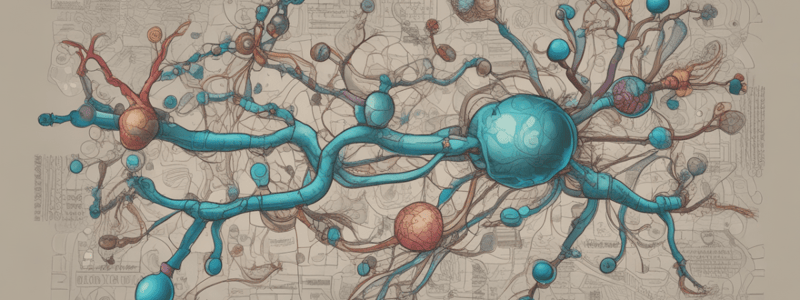Podcast
Questions and Answers
What is the primary function of the consensus sequences GT at 5'-end and AG at 3'-end of introns?
What is the primary function of the consensus sequences GT at 5'-end and AG at 3'-end of introns?
- To regulate the frequency of translation
- To ensure the fidelity of transcription initiation
- To specify the amino acid sequence of a protein
- To facilitate the splicing of introns from the primary transcript (correct)
What is the consequence of a mutation at the splice sites of an intron?
What is the consequence of a mutation at the splice sites of an intron?
- An increase in the frequency of transcription
- A loss of gene production (correct)
- An enhancement of mRNA export
- A frameshift mutation resulting in an abnormal protein
What is the function of the TATA box in the promoter region of a gene?
What is the function of the TATA box in the promoter region of a gene?
- To bind with ribosomal RNA and facilitate translation
- To direct the RNA polymerase II to the correct start site and ensure fidelity of initiation (correct)
- To specify the amino acid sequence of a protein
- To regulate the frequency of mRNA export
What is the role of the 5'UTR in the mRNA strand?
What is the role of the 5'UTR in the mRNA strand?
What is the consequence of a mutation in the exons of a gene?
What is the consequence of a mutation in the exons of a gene?
Flashcards are hidden until you start studying
Study Notes
Transcription Process
- Initiation: involves formation of the basal transcription complex, including:
- TATA-binding protein (TBP) binding to the TATA box
- Transcription factors TFII A and B binding to TBP
- RNA polymerase II binding to these factors and DNA, aligning at the start point for transcription
- TFII E, F, and H binding, with TFII H acting as an ATP-dependent DNA helicase
- Elongation: the process of transcribing by RNA polymerase II, characterized by:
- 5'→3' growing chain
- RNA polymerase II recognizes the start point and DNA template, reads DNA 3'→5', and uses the antisense strand (3'→5') of DNA as a template
- No primer is needed, and 3'→5' phosphodiester bond is catalyzed
- RNA polymerase II progresses along the DNA template, leaving the complex behind, with a constant synthesis rate of about 30-40 nucleotides per second
- Termination: a sequence-dependent termination of RNA chain growth, involving:
- RNA polymerase reaching a 3' termination sequence (polyadenylation signal, AAUAAA)
- RNA polymerase stopping and falling off the DNA template strand
- Pre-mRNA molecule being released, and DNA strands re-forming a double helix
Post-transcriptional Processing (RNA Processing Reactions)
- Conversion of pre-mRNA (hnRNA) into mature mRNA, involving:
- Capping: addition of a 5´cap, which protects the mRNA from degradation and increases translation efficiency
- Tailing (polyadenylation): addition of a 3´polyA tail, which protects the mRNA from degradation
- Exon structure: composed of Untranslated regions (UTRs) and coding regions, with mutations leading to abnormal protein
Gene Structure
- Transcribed region:
- Introns: characterized by not coding for amino acids, being removed from mature mRNA, and having consensus sequences (GT at 5'-end, AG at 3'-end) for splicing
- Mutation at splice sites results in loss of gene production
- Regulatory regions:
- Promoter: consisting of a few hundred nucleotides upstream of the gene, controlling transcription initiation and frequency
- Consensus sequences: TATA box (TATA(A/T)A) located at -25 region, binding with general transcriptional factors and directing RNA polymerase II to the correct site
Studying That Suits You
Use AI to generate personalized quizzes and flashcards to suit your learning preferences.




